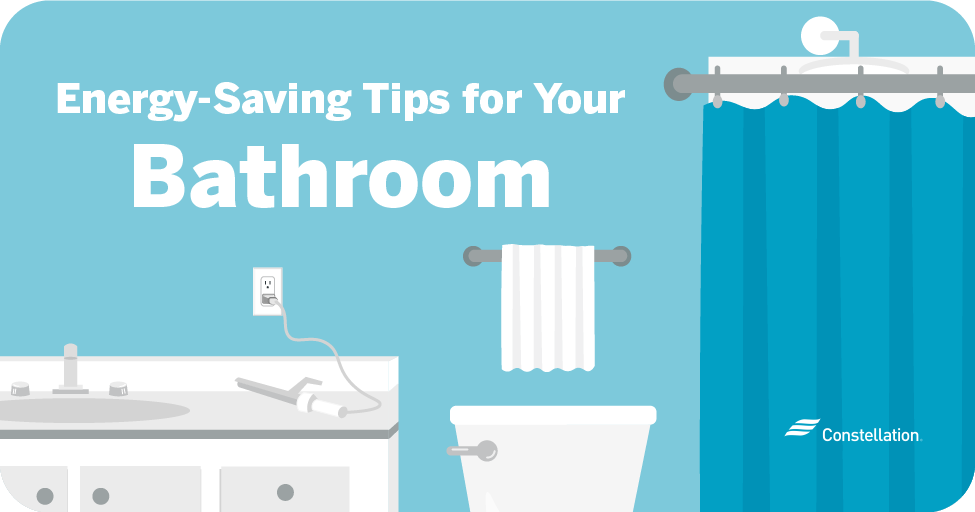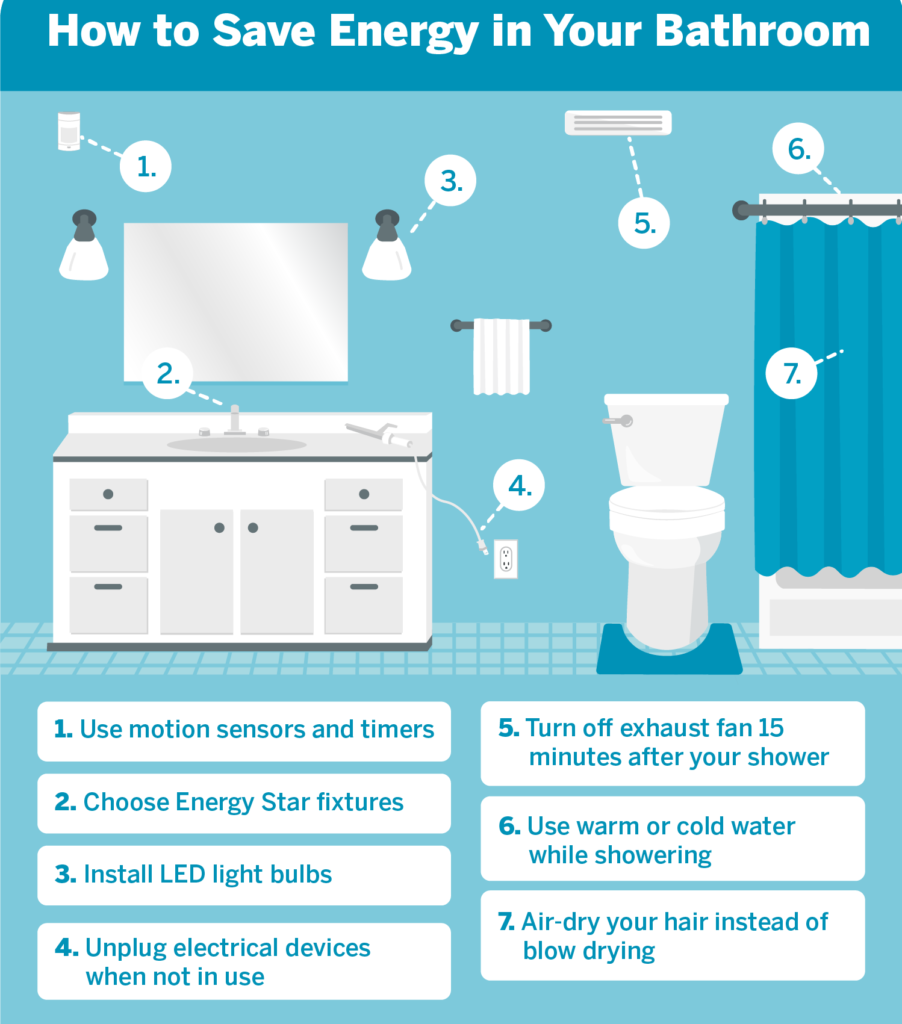
- Category:
Energy Efficiency -
Last updated:
June 19, 2025
Energy-Saving Tips for Your Bathroom
The average American uses 80 to 100 gallons of water a day, most of which is used in the bathroom. Changes in rainfall and weather patterns, coupled with a growing interest in sustainability, have led many Americans to adopt strategies to conserve energy and water. Knowing how to save water in the bathroom can lower your utility costs, as can installing energy-saving bathroom bulbs and following other smart bathroom tips that will help you save on energy use.
How to save energy in your bathroom

Use warm or cold water. Water heating accounts for 18% of a home’s energy consumption. Showering or washing your hands in warm or cool water, especially during hot weather, helps with summer energy conservation. Showering with hot water in the summer also adds unwanted heat to your home, making it difficult to maintain a comfortable interior temperature.
- Unplug all electrical devices when they’re not in use. A simple change in habits goes a long way toward achieving energy-efficient bathrooms. If electronic bathroom devices are plugged in, many of them can consume energy even when they’re not in use. Unplug hair dryers and straighteners, electric toothbrushes and electric razors when you finish using them.
- Install energy-saving bathroom bulbs. Energy-efficient bathroom lighting provides the brightness you need without the energy demands of traditional incandescent lights. Switching to energy-saving bathroom bulbs such as LEDs is an easy way to reduce bathroom energy use, especially as LED lights can last decades. Energy-efficient bathroom lighting also generates less heat than incandescent bulbs, making the room more comfortable.
- Use motion sensors or timers. Forgetting to turn off bathroom lights is a frequent occurrence — especially in homes with kids. Connecting motion sensors or timer switches to bathroom lights ensure you won’t be burning energy when no one is using the room.
- Air-dry your hair. Some energy-efficient bathroom tips are remarkably simple. By choosing to air-dry your hair, you save on the energy used to power your hairdryer. It’s a small change, but it can save energy over the long run.
- Turn off your exhaust fan. Bathroom exhaust fans remove hot, humid air from your bathroom, which helps maintain a comfortable and healthy home environment. These fans don’t need to run continuously, though. The average bathroom fan will remove humidity within 15 to 20 minutes — there’s no reason to leave the fan running longer than that. Adding a timer switch to your fan allows it to do its job without wasting energy.
- Look for ENERGY STAR® bathroom fixtures. When choosing new light fixtures and fans for your bathroom, look for models with the ENERGY STAR® symbol. These models are tested to ensure that they use energy more efficiently than other models.
Pro tip! As noted above, heating water consumes up to 18% of a home’s total energy use. So, it makes sense to use the most energy-efficient water heater possible. Selecting a water heater includes judging the merits of electric vs. gas water heaters (gas is generally the cheaper utility, but electric heaters are generally more efficient) and choosing the model that’s right for you. You may also want to consider whether you’d be better served by a tankless water heater.
How to save water in your bathroom
Determining how to save water in the bathroom is perhaps the most crucial part of an energy-efficient bathroom plan. Aside from the benefits of saving extra energy required in water treatment, conservation is increasingly important in arid regions, and people are learning to value freshwater even in areas where water resources are abundant.
Showers and tubs

One of the most common energy-efficient bathroom tips is to shower instead of bathe. Showering uses less water than bathing, and energy-efficient bathrooms use as little hot water as possible. You can reduce your water and energy use even more with the following shower tips.
1. Take shorter showers.
Shorter showers conserve energy. It goes without saying that a 15-minute shower uses more energy and water than an eight-minute shower. To gain an understanding of how much water you use when you shower, check out our shower water usage flowchart.
2. Install a low-flow shower head.
Low-flow shower heads save water by reducing flow rates to 2.5 gallons per minute or less. While most modern shower heads are low-flow, older models may have higher flow rates. Replacing older models with energy-efficient shower heads will reduce the amount of water used per shower.
3. Try a “Navy shower.”
If you’re serious about water conservation, you could take a “Navy shower.” Designed to conserve freshwater while on deployment, Navy showers (or GI baths) are easy to learn. First, turn on the shower to wet yourself down. Then, turn off the water while you lather up. Finally, resume the shower and rinse the lather off. This technique significantly reduces the amount of water you use during a shower.
4. Collect water in a bucket.
Running a shower until it’s the right temperature wastes water. If you’re waiting for the water to warm up, put a bucket in the shower. The bucket will catch water that would otherwise go down the drain, and any water you collect can be used to water plants.
5. If bathing, fill the tub halfway.
It takes 35 to 50 gallons of water to fill a bathtub, which is obviously more than the 25 gallons used during a 10-minute shower. If you prefer to bathe, you can save water by only filling the tub halfway.
Pro tip! Using cooler water in the summer makes sense, but what about when the weather is cold? One of the most energy-efficient ways to heat a bathroom is with radiant floor heating. It’s healthier than forced-air heat, and it means no more stepping from the shower onto an icy tile floor!
Sinks

Sinks are another water-wasting culprit. Simply washing your hands can use a gallon of water — more if you run the tap until the water gets hot. Keeping your faucets in good condition, fixing leaks promptly, addressing sink clogs and changing a few hygiene habits can help reduce water consumption at the bathroom sink.
1. Look for WaterSense faucets.
WaterSense-labeled faucets are low-flow faucets capable of saving 30% of the amount of water that flows through a faucet every minute. While standard faucets have a flow rate of 2.2 gallons per minute, WaterSense faucets use no more than 1.5 gallons per minute.
2. Install an aerator.
Installing new low-flow aerators is an effective way to conserve water flow on older faucets. Look for the WaterSense label on replacement aerators. Be sure to bring your old aerator to the store to make sure the new aerator will fit your faucet.
3. Turn off the tap when brushing your teeth.
People tend to leave bathroom taps running when they’re doing “quick” tasks. After all, how much water will be wasted in the time it takes to brush your teeth? Quite a bit, as it turns out: Turning off the tap while brushing can save up to 200 gallons a month.
4. Fill up the basin with water when shaving.
Like when you’re brushing your teeth, leaving the faucet running while you shave wastes water and energy. Instead, fill up the sink halfway and then shave. You’ll save water without extending how much time you spend shaving.
5. Fix leaky faucets.
According to the EPA, the average household loses almost 10,000 gallons of water to leaky faucets and pipes every year — with 10% of homes losing 90 gallons to leaks every single day. Check faucets and bathroom pipes for leaks regularly, and fix any leaks you find as soon as possible.
Toilets

Finally, we get to one of the largest users of water in the bathroom: the humble toilet. The average toilet uses 3 gallons per flush, and the average person flushes about five times a day. A family of four, then, might use 60 gallons of water a day just flushing. Fortunately, there are ways to reduce your toilet’s water use.
1. Choose high-efficiency toilets.
High-efficiency toilets use water velocity instead of water volume to remove waste. As such, these water-saving toilets can flush out a toilet bowl using as little as 1.28 gallons.
2. Put a plastic bottle in your toilet tank.
If you’re not ready to replace an older toilet, you can reduce the amount of water used per flush with this simple trick. Fill a plastic bottle with water, sand or rocks and place it in the tank, making sure the bottle doesn’t touch any moving parts. The bottle displaces water, reducing the amount used with each flush.
3. Make sure your toilet stopper seals after every flush.
If your toilet continues to run after the tank refills, the toilet stopper or flapper may not be sealing correctly. Left alone, an unsealed stopper can waste hundreds of gallons (costing hundreds of dollars) of water over the course of a year. A new flapper costs about $10 and can be installed by most people with basic DIY skills.
4. Install a toilet fill cycle diverter.
Toilet fill cycle diverters help conserve water by diverting a portion of the water that would otherwise sit in the bowl to the tank. Less water sits in the bowl, and the tank fills faster. With the right diverter, you can save up to a half-gallon per flush.
5. Toss trash in the can, not the toilet.
Waste and bathroom paper are the only items that should be flushed down toilets. When people flush cigarette butts, paper, plastics, and other items, they’re wasting up to 3 gallons per flush that could be saved by depositing such items in the trash. Using the toilet as a trash can also introduce items into water treatment plants that force the plant to work harder.
Energy-efficient bathrooms don’t require extensive renovations. With some simple lifestyle changes, some inexpensive plumbing equipment and LED lights, you can cut down on the amount of energy and water that, in some cases, is literally going down the toilet.




